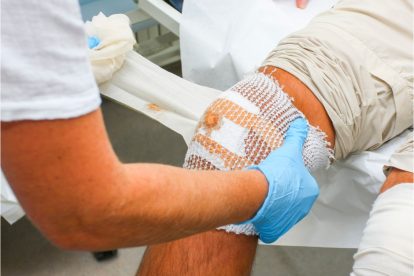Introduction
Wound treatment administration is a necessary aspect of medical care, especially in the therapy of persistent wounds and complicated injuries. Whether it's a straightforward cut or a more challenging abscess, reliable wound monitoring can dramatically influence recovery end results. Appropriate approaches not just expedite recovery however likewise decrease the threat of infection and problems. As health care professionals, comprehending these methods is vital. In this write-up, we delve deep into Wound Care Monitoring: Approaches for Successful Outcomes, including various facets such as training for specialists, nursing education and learning, and progressed techniques for managing intricate wounds.
1. Understanding Injury Treatment Management
1.1 What is Injury Care Management?
Wound care administration refers to the systematic strategy to treating wounds via correct analysis, diagnosis, and treatment protocols. It consists of whatever from cleaning and dressing injuries to surveillance healing progress.
1.2 Significance of Wound Care
Effective wound care is important due to the fact that it aids protect against infections, advertises faster healing, and inevitably lowers medical care expenses nursing wound care training connected with prolonged treatments.
2. Types of Wounds
2.1 Severe Wounds
Acute wounds are those that heal quickly without difficulties. They normally result from surgical treatment or unintended injuries.
2.2 Persistent Wounds
Chronic injuries continue in time and are usually related to underlying conditions such as diabetes or vascular disease.
3. The Duty of a Wound Treatment Specialist
3.1 What Does an Injury Care Expert Do?
A wound treatment expert focuses on diagnosing and treating various sorts of injuries using specialized expertise and techniques.
3.2 Training Required for Specialists
To become an injury treatment specialist, one need to go through extensive training that consists of both academic understanding and useful skills.
4. Wound Care Professional Training
4.1 Overview of Educating Programs
Training programs for wound care professionals vary extensively yet commonly consist of coursework on makeup, physiology, and the most recent wound treatment technologies.
4.2 Accreditation Options Available
Various organizations use certifications in wound care management that improve trustworthiness and competence in the field.

5. Wound Care Educating for Nurses
5.1 Value of Specialized Training
Nurses play a critical role in patient treatment; thus, specialized training in wound monitoring is crucial for supplying top quality healthcare services.
5.2 Curriculum Components in Nursing Programs
Most nursing programs now integrate components concentrated on basic wound care training to gear up registered nurses with fundamental skills needed in clinical settings.
6. Wound Care Training Courses
6.1 Online vs On-site Courses
With the surge of digital learning systems, many specialists are choosing on the internet wound care training courses that offer flexibility without jeopardizing on quality.
6.2 Program Material Overview
Typical program web content includes anatomy relevant to wound healing, finest methods in clothing application, infection control steps, among others.
7. Basic Wound Care Training Essentials
7.1 Trick Skills Acquired Through Standard Training
Basic wound care training furnishes individuals with skills like cleaning methods, using dressings appropriately, and recognizing indicators of infection.
7.2 Relevance of Hands-on Practice
Theory alone isn't sufficient; hands-on technique is vital for establishing self-confidence and efficiency in managing wounds effectively.
8. Advanced Methods in Intricate Wound Care
8.1 Comprehending Complex Wounds
Complex injuries require customized treatments because of their nature-- typically including deeper cells or underlying health concerns that impede recovery processes.

8.2 Therapy Modalities
Advanced modalities consist of unfavorable pressure wound therapy (NPWT), bioengineered tissues, and other innovative strategies tailored to advertise recovery in complex cases.
9. Chronic Wound Care Management Strategies
9.1 Identifying Underlying Causes
Identifying the source of chronic injuries-- be it bad circulation or diabetes mellitus-- is crucial for efficient treatment plans.
9.2 Multidisciplinary Approach
An effective chronic wound monitoring strategy typically involves partnership among numerous healthcare providers consisting of dietitians, podiatrists, and physical therapists.
10. The NDIS (National Impairment Insurance System) & Injury Care
10.1 NDIS Assistance Services
For individuals under the NDIS structure needing continuous injury administration assistance services are crucial to ensure they obtain proper care customized to their needs.
10.2 Financing Options Available
Understanding financing choices readily available through NDIS permits patients to accessibility necessary therapies without economic burden.
Frequently Asked Inquiries (Frequently asked questions)
Q1: What qualifications do I need to come to be a wound treatment nurse?
A: Normally requires a nursing degree along with specialized certification in wound administration obtained via recognized programs or programs focused on nursing injury care training.
Q2: The length of time does it require to complete a wound care training course?

Q3: Can I handle my own chronic wounds at home?
A: While some people can manage small persistent injuries at home with correct education and learning from healthcare providers, serious instances ought to constantly be assessed by professionals to avoid complications.
Q4: Why is infection control vital in injury management?
A: Infection control prevents issues that can develop from untreated infections which might postpone recovery or result in extra serious health problems needing comprehensive medical intervention.
Q5: Exist specific items recommended for chronic wound management?
A: Yes! The option of products relies on the kind of chronic injury; usual options consist of hydrocolloid dressings, alginates, foam dressings and so on, customized based on private requirements examined by health care providers.
Q6: Exists recurring education and learning offered after preliminary certification?
A: Definitely! Many companies motivate continuous specialist development through workshops, seminars, online sources making certain professionals stay current with advances in efficient techniques associated with persistent wound treatment management.
Conclusion
In conclusion, reliable Wound Treatment Monitoring: Techniques for Successful Outcomes rely greatly on competent experts who recognize both standard concepts and progressed techniques vital for advertising optimum recovery problems throughout diverse patient populations-- from intense injuries requiring prompt attention to complicated chronic wounds needing ongoing analysis and treatment methods customized towards all natural health objectives. By focusing on education with extensive training programs created especially around evolving standards within this dynamic area-- healthcare specialists can enhance their capacity delivering exceptional service while making sure favorable person experiences producing effective end results over time.